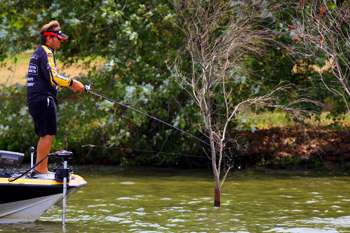
If anyone in the Elite Series is qualified to talk about moving water, it's Greg Hackney. He grew up fishing the Arkansas and Mississippi Rivers and has an encyclopedic knowledge of these systems and the fish they keep. When the Elite Series has visited the Arkansas River, he has scored two second place finishes and one eighth place. Hackney also claims several Top 10 finishes on the Alabama River in the Elite 50. He believes that a few fundamentals can make anyone a moving water pro.
Hackney defines two categories of moving water: fast and slow. Water is fast when you can't swim against it, and everything else is slow water. With that, he also says that some of his best fishing has been in water so fast most people wouldn't think of fishing, so don't count out very swift water. Fast and slow water take two very different approaches, but the one thing in common is that the fish will usually be in the same general places.
FIND 'EM FIRST
Hackney says that nearly all fish in moving water will be found five feet or shallower. This is because the structure they use to escape the current is typically within this range.
Hackney also says that fish in moving water are target oriented, meaning they will be in very predictable places, or targets. He says they will be around or behind anything that breaks the current; they won't be all over the place like in a lake. This makes them easier to find.
"In slow water, the fish will be upstream of the cover, be it a log, brushpile or rockpile, because that will be the first place bait will wash by," he says. "In fast water, they can't fight the current for long, so they hunker real close on the downstream side of the cover in an eddy spot and stick their head out into the current to grab any bait that happens by."
LAZY RIVERS
While fishing slow water may seem easy, it has its share of challenges. Holding position may be accomplished with a trolling motor, but requires considerable experience in manipulating it. But when done properly, troll holding is the best way to attack a river's cover. Hackney says that the fish will relate more loosely to cover in slow water, as they can maneuver with less effort.
"The key here is to make your bait seem as natural as possible when moving downstream," the Louisiana pro says.
When fishing slow water, Hackney typically casts to cover with a spinnerbait, or a crankbait. From a downstream position, he casts upstream of the target and lets the bait roll naturally by the cover. "Naturally" meaning the same general speed as the water current. He prefers Strike Kings Series 3 crankbait in Sexy Shad for clear water, and chartreuse patterns for stained water. Hackney fishes his Strike King Premier Elite spinnerbait in the same natural manner.
His casting outfit consists of a 7-foot medium-heavy Quantum cranking rod mated to a Quantum PT reel spooled with Gamma fluorocarbon. He prefers fluorocarbon because it is dense and catches water better than other lines, which moves the bait more naturally in the current.
SWIFT WATERS
In fast currents, a different approach is needed as baits can be swept downstream before fish can even think about striking. Positioning your boat can also be a challenge. Hackney says that you should drive downstream of your target and pull in to the same lull in current the fish are holding in, so neither of you gets swept away. The current will mask your presence. When selecting cover to fish, Hackney looks for what he calls "complex structure," or anything that has multiple cover points for fish to hide in. There will be more fish in these larger structures.
Hackney says heavier baits are necessary to combat faster water. He likes tubes, such as Strike King's Bleeding Bait with a 3/8 or 3/4-ounce weight, and jigs, specifically Strike King's Premier Elite in either 3/8- or 3/4-ounce trailed by any of Strike King's 3X flipping chunks.
"You need to get that bait down fast before it gets swept away," he says. "Once you've got it down there, keep it looking as natural as possible by maintaining the same speed as the current on your retrieve."
Hackney says keeping the jig on the bottom is critical to feeling a strike. Otherwise the current may take it, making the pull indistinguishable from a fish's.
Hackney also says that when in fast water, the fish will stick closer to the cover on the downstream side, making it even easier to target them. He uses his 7-foot 11-inch heavy action Quantum Signature Series rod with a fast taper and flips his bait as close to the cover as possible. Fifty-pound braid is spooled on a Quantum PT reel because he says the braid doesn't pull as much water because of its smaller diameter, letting him work the jig without having it blown away by current.
Hackney has enjoyed much success on rivers and moving water, drawing from decades of experience. Hackney believes that moving water is much simpler than it appears to be, and given all his success, it is wise to listen when he talks.




